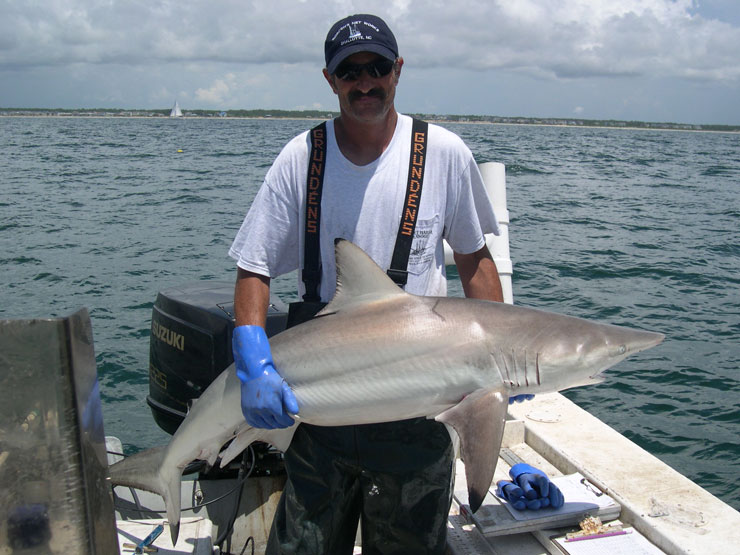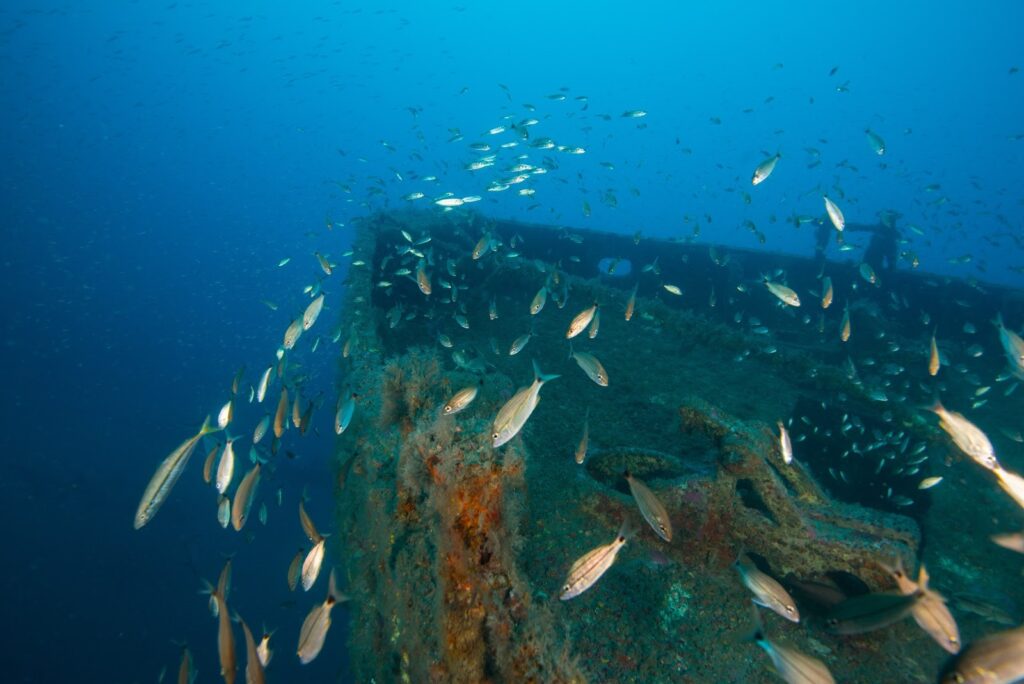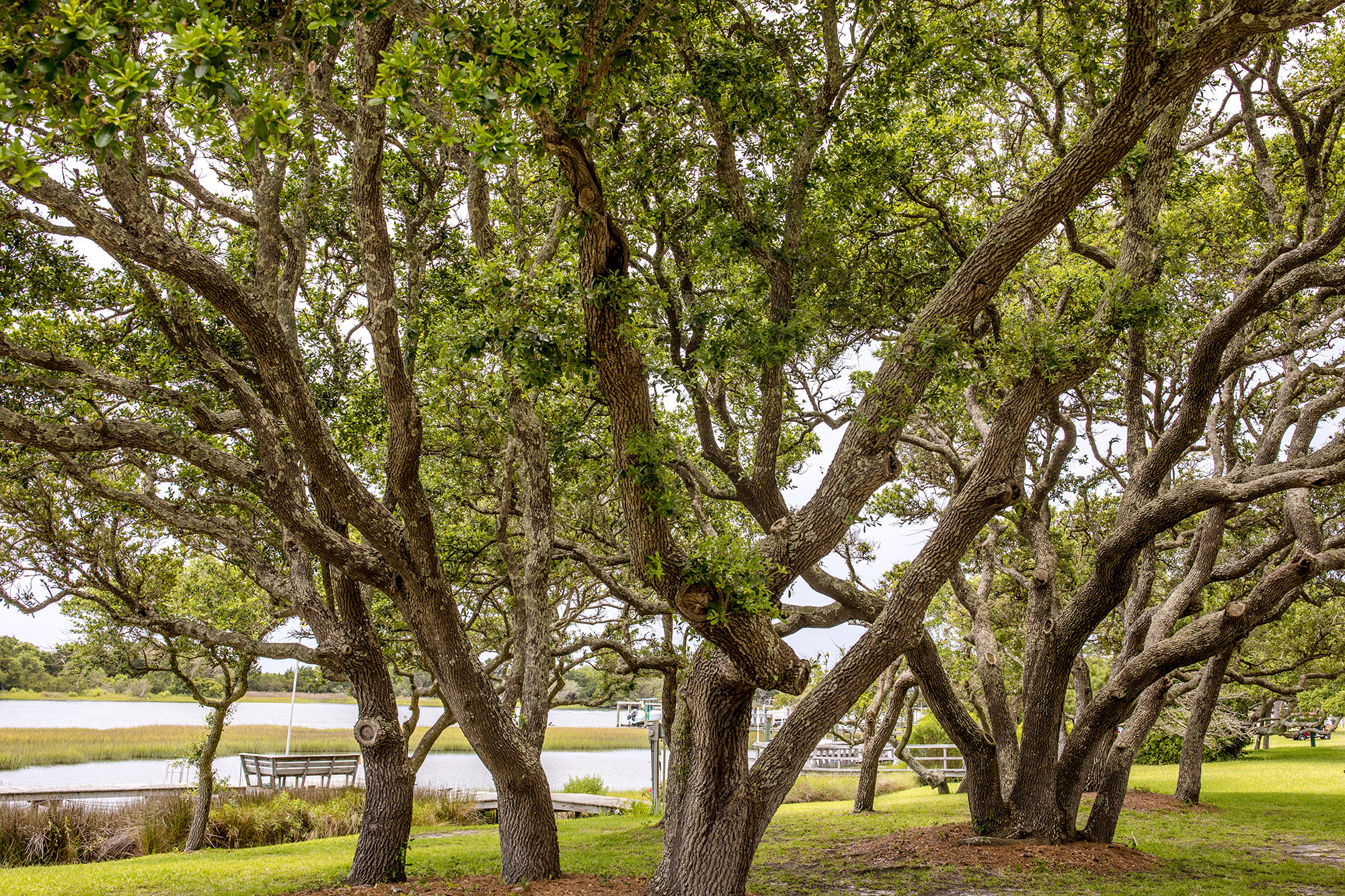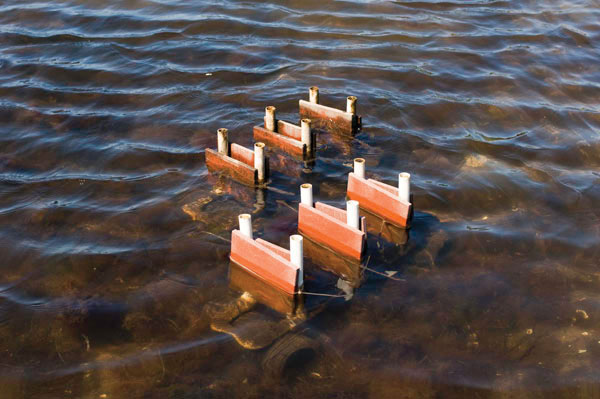Fins to the Left, Fins to the Right: Netting Sharks To Snare Data for Fisheries Management

Skies over the English Channel are clear. Sunlight sparkles on the breaking waves hundreds of feet below the sandstone cliffs on which a young girl keeps her vigil, gazing out to sea.
Suddenly, she sees it. Cruising along the surface is the great, dark, slowly moving form for which she has waited: a migrating basking shark.
The plankton-filtering fish, at up to 26 feet long, is the second largest after the whale shark, possibly longer than the great white shark of Jaws infamy.
Such sea creatures have enthralled Teresa Thorpe — a shark researcher who works closely with North Carolina Sea Grant — since her childhood on England’s southwest coast. Her fascination with aquatic life later led her to the University of London, where she earned her doctorate in marine biology, specializing in shark bycatch and mitigation. Eventually, it led her to the University of North Carolina Wilmington’s Center for Marine Science, where today she is a research biologist.
Shortly before Thorpe came to North Carolina, Dave Beresoff, a commercial fisherman, was working with Mary Moser of UNCW’s CMS, researching gill net selectivity for sharks off North Carolina’s southern coast.
As a citizen scientist, Beresoff, who studied marine science at Dowling College in New York, also had researched blue crab, red drum, mammal bycatch by commecial fishermen, and other topics, usually with academic researchers.
The North Carolina Fishery Resource Grant Program, funded by the N.C. General Assembly and administered by North Carolina Sea Grant, has supported his past and present research.
Earlier in his career, Beresoff even fished commercially for sharks. His decades as a waterman developed the kind of experience that makes fisherman-resesarcher partnerships so effective. “It takes fishermen with knowledge of the local area to work with academics so they can get confident data to present to the regulatory committees,” he says.
And Beresoff should know, having served on both the N.C. Marine Fisheries and Coastal Resources Commissions.
DATA HARVESTING
Data from studies conducted by FRG researchers — including Thorpe and Beresoff, who first worked together in 1998 on a shark-related gill net study — help marine and coastal fisheries agencies such as the N.C. Division of Marine Fisheries and the National Marine Fisheries Service to improve species-specific management plans, practice habitat conservation and restore degraded marine areas.
In 2006, NMFS mandated that essential fish habitat data be incorporated into all fishery management plans. That includes shark fisheries.
“Essential fish habitat is crucial for fishery management plans and enacting effective management,” says Chip Collier, DMF’s southern district biological supervisor. “Teresa and Dave’s work will help to elucidate locations of essential fish habitat for a variety of shark species,” he adds.
“To properly manage a fishery resource,” notes Steve Rebach, North Carolina Sea Grant’s associate director, “managers need to know how many and what kind of fish there are, and when and where they breed.
“This requires knowledge of coastal habitats and how vital reproductive and nursery areas might be protected through the N.C. Coastal Habitat Protection Plan,” says Rebach, who coordinates research for Sea Grant.
Why protect sharks?
Fishermen net sharks accidentally as bycatch, but also harvest them intentionally for food — such as fish and chips and cod liver oil substitutes — and several other uses.
“The balance,” says Thorpe, “is harvesting them at a sustainable level. We also need to adopt sensitive coastal management strategies to support the sustainable harvest of our valuable aquatic resources.”
And solid shark science requires oceangoing studies.
To that end, Beresoff, Thorpe and team embarked last spring on their most recent project: a yearlong quest to locate potential nursery areas where pregnant female sharks and their pups congregate and linger. The team also includes Warren Mitchell, a marine biologist and the 2006 North Carolina Sea Grant/DMF Marine Fisheries Management Fellow. Thorpe conducts the field research for the study’s southern region. Mitchell, based at N.C. State University’s Center for Marine Sciences and Technology in Morehead City — or CMAST — is biologist for the study’s northern area.
“If big, pregnant females are swimming in the same area as neonates, or babies of the same species, maybe it’s a nursery ground,” Thorpe says. “We wanted to fully investigate essential shark habitat along a variety of gradients: whether they like shallow water, high- or low-salinity water, certain temperatures, sandy or grassy bottoms.”
The researchers also are considering how sharks use nearshore and coastal areas, what makes an area essential for sharks, and how to use the study’s data for sensitive coastal management and the restoration of degraded areas, she adds.
The large variety of sharks cruising off North Carolina’s coast seems to argue for a diverse fisheries management strategy, researchers such as Thorpe and Beresoff suggest. “What you’re seeing is this fantastic mixing area off Cape Hatteras, which acts as a natural geographic boundary,” Thorpe explains. “You can’t just manage all sharks as a whole unit due to wide differences in shark species abundance and diversity.”
The state’s southern ocean waters, influenced by the warm Gulf Stream, show higher catches of finetooth, blacknose and bonnethead sharks, while fewer of those species are caught in the central region. The more northerly region shows a higher catch rate of dusky and sandbar sharks.
The more diverse a system, the more stable it is. A decline in diversity — that means sharks, too — likely will affect many ocean processes, including food production, Thorpe explains.
For example, in 2008, Florida researchers noted that a decline in large coastal shark species in the Northwest Atlantic was concurrent with an increase in catch rates of cownose rays.
“The cownose ray is a voracious consumer of bay scallop,” she says, “and it was suggested that the scallop decline was linked to an increase in cownose rays.
“Further, if you degrade a nursery area, you may limit the ability of a species to bounce back from overfishing,” Thorpe says.
As an example, she notes, the blacknose was considered in 2009 to be overfished. “It was managed as part of the small coastal species management unit, included with the other small coastal sharks,” she explains. “Now it is managed on its own, with its own seasons and quotas and the catch will be severely limited.”
SHARK SPOTTING
For this project, the researchers examined ocean and inland waters in two of North Carolina’s three fisheries management areas.
The state’s central fisheries region, which marks the study’s northern boundary, extends from Cape Lookout south to the White Oak River, in- and offshore of Carteret County. The team also sampled waters in- and offshore of Brunswick County from south of the Cape Fear River to the South Carolina border, which coincides with the fisheries’ southern region. Beresoff says he and other fishermen, working with academic researchers, can consistently locate fish for the needed data using dead reckoning, GPS and a lifetime knowledge of local conditions.
For instance, he maintains, experienced fishermen know that “sharks have to be moving to catch them in a net. I know in my mind the correct corridors where the sharks would travel. To give an analogy: If you were looking to catch autos, you wouldn’t look in a parking lot. You’d look to the constant flow on 1-95.”

The researchers made eight runs to gill nets set earlier by Beresoff at both sampling areas from May to August and from September to November 2010, with another eight dual sets planned for spring 2011. Beresoff captained a 22-foot vessel with a 225-horsepower Honda outboard, and his crew varied with each trip. The teams included Thorpe recording data for Brunswick County runs. Mitchell served as biologist and Jeff Merrell, a CMAST technician, recorded data for the Carteret runs.
At each net, the researchers measured water depth, salinity and surface temperature, as well as bottom sediment type and distance to shore.
In 2010, they caught sharks in three areas: deep offshore, in shallow nearshore waters and behind barrier islands.
In deep offshore waters, up to three miles from land, at depths of 30 to 45 feet, the bottoms were composed of sand and isolated rock reef structures.
In shallow nearshore coastal waters, from the beach to about a half mile out, at less than 20 feet deep, the bottoms were predominantly sand.
Behind barrier islands, in estuaries, where sample high-tide depths were about six feet, the bottoms were a sand-mud mix, with isolated oyster rock, shell or eelgrass patches.
TO CATCH A SHARK
Sharks of various sizes and species are snared in commercial fishers’ nets as bycatch, but they’re not necessarily easy to snag on purpose.
To do so, researchers used 300-foot-long gill nets constructed by Beresoff. Specific net mesh widths allow the appropriate-size animals to enter, but when they try to back out, the net snares their gills. The net is composed of panels, with mesh diameters of three, four and five inches.
The net’s weighted bottom line must stay in place, so the top line has weak links a 40- to 60-ton whale can break through and not take the line out. The net is weighted with number 22 Danforth anchors to keep the lead line in place.
“The net had weak links spaced 50 yards apart along the top of the float line,” Beresoff explains. “This ensures that a whale can break the top or float line and not become entangled in the gear. They hit it like a Greyhound bus hitting chain link fence.”
Sometimes, to land powerful larger sharks, he also sets 1,000-foot baited longlines with circle hooks.
“Although you’d think the gill nets would catch larger fish, some sharks just barrel through,” Thorpe says. “We had caught large blacktips in previous studies and we caught a tiger shark on a longline off Carteret County during this assessment. She was huge, approximately nine feet long.”
Last summer, the team set and hauled gill nets the same day, so larger sharks would not suffocate in warm waters as they thrashed about. In the spring and fall, they set lines before sunset and hauled in after sunrise the following day, as captured shark mortality drops during those periods. That’s because the species snagged then tend to be smaller and the cooler water is more oxygenated, Thorpe notes.
Some species, such as smooth and spiny dogfish, do not have to swim constantly to oxygenate their tissues, increasing their ability to survive in a gill net.
“We have a policy that if a shark is alive, we get it back in the water as soon as possible,” Beresoff adds.
Summer 2010 catches off Carteret included seven shark species, with Atlantic sharpnose dominating with 137 captured. Scalloped hammerhead ran a distant second with 14. The Brunswick count was six species, with 157 Atlantic sharpnose, 76 bonnethead and 19 blacknose. The next highest counts for other species were considerably less in all cases.
Off Carteret, the nets caught four shark species in the fall sampling. The most prevalent again were Atlantic sharpnose (239), with the sandbar next most prevalent (20). Off Brunswick for the same period, four species were caught in the nets, with sharpnose numbering 358. The next highest were spinner, with only six.
Sharks were largely absent from internal waters’ sets in both seasons and study areas. While sometimes complex seasonal restrictions apply, as of earlier this year recreational and commercial takes of Atlantic sharpnose, bonnethead, blacknose, finetooth and scalloped hammerheads were legal. It is always illegal to land sandbars. Also, large coastal and pelagic sharks — shortfin mako, porbeagle, common thresher, oceanic whitetip and blue — must be more than 54 inches long to be legal.
Sharks? Really?
Thorpe often is asked why she researches sharks, seen by many as dangerous predators. She responds, in part: “Sharks have much more to fear from us, from overfishing, high bycatch, finning — taking the fins only and discarding the live carcass — and ill-informed attitudes.
“They are not eating machines out for a tasty human body, far from it. There are thousands of sharks swimming in North Carolina’s nearshore waters and yet attacks are extremely rare. “It is important to maintain genetic biodiversity and sharks are an important and critical component of our oceans’ ecosystem.
“Removal of large predators in the ocean has implications for broader ecosystem disturbance and degradation,” Thorpe continues. “This is referred to as a ‘top-down trophic cascade,’ which is the effect a change in the size of one population in a food web has on those populations below it.”
Best. Day. Ever.

In more than a decade of ocean-related research off North Carolina shores, Thorpe has seen her old friends, the basking sharks, only once.
On a spring day several years ago, “We saw what looked like a giant box floating on the water, so we went to investigate and potentially remove it. It was the dorsal fin of a large basking shark, more than 20 feet long, bigger than our boat, perhaps a mature animal,” she relates.
The shark repeatedly swam under the boat, investigating it, perhaps thinking the craft was another shark, Thorpe says.
“Then it swam to our stern and lined up as if to follow us, but at the last second it turned away,” she continues. “I believe it really did think we were another basking shark, given its nose-to-tail with our boat swimming behavior.”
The researchers turned their boat’s engine off and floated with the shark for a half hour or so before reluctantly heading back to port. But on the way, Thorpe, Beresoff and crew then spotted a second, smaller basking shark, about 12 feet long, probably a juvenile.
“Imagine our surprise and elation! It, too, was feeding on the surface, mouth agape, filtering plankton,” Thorpe says.
And as if that weren’t enough for one day, the crew and a UNCW student on board heard a mighty splash and turned astern to see a humpback whale.
“I thought, ‘this is what it’s all about.’ It was truly an incredible day,” she says. “The aura of these magnificent animals impresses, no matter what. A day like that makes up for the many when we are rolling around in rough seas, after chipping ice off the gunwale in order to cast off.
“You never know what you’re going to find out there,” Thorpe muses. “Wouldn’t it be a shame if we degrade habitats or overfish the nurseries and lose all this biodiversity?”
Pertinent URLs
This article was published in the Spring 2011 issue of Coastwatch.
For contact information and reprint requests, visit ncseagrant.ncsu.edu/coastwatch/contact/.
- Categories:


